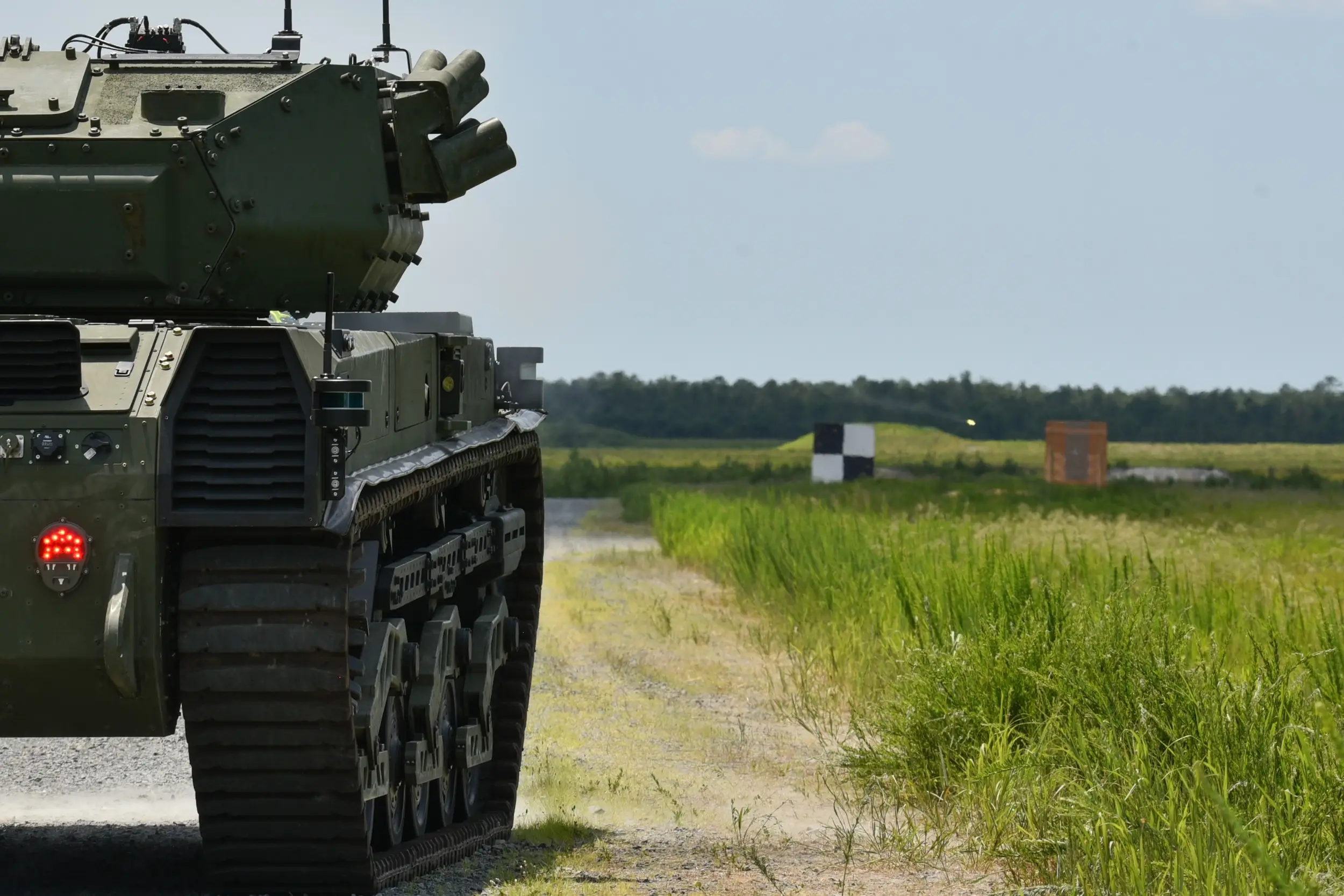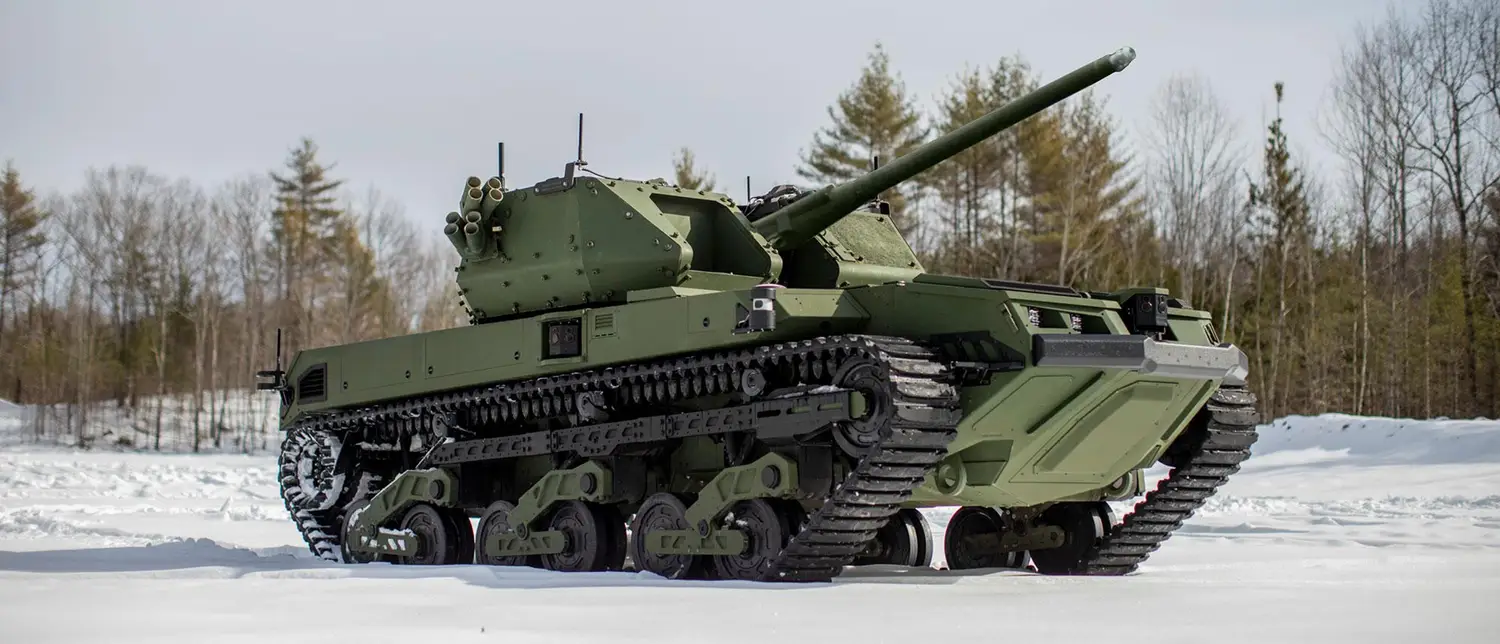
REPORT HOME > AT THE CONTROLS
JULY 2023 | TECHNOLOGY REPORT | UGVs
As the US leads the way in introducing large armed and armoured robotic systems, how will this unlock the interconnection of UGVs across multiple missions in multi-domain operations?
Above: The overarching RCV effort is designed to employ external or onboard weapon systems while reducing the tactical risk to a US Army formation. (Photo: US Army)
In an age of strategic competition, uncrewed ground vehicles (UGVs) are set to play a critical role in extending the capability of armed forces to overmatch peer adversaries and maintain tactical and strategic advantage.
Prime examples include the US Army’s Robotic Combat Vehicle (RCV) programme which will provide a ‘revolutionary capability that will forever change the conduct of warfare’, according to service officials.
The RCV Middle Tier Acquisition – Rapid Prototyping (MTA-RP) pathway, currently being developed as part of the army’s Next Generation Combat Vehicle (NGCV) family, is focused on two concurrent efforts, according to the army.
These include delivery of the RCV-Light variant and a Software Acquisition Pathway which is designed to develop the necessary applications to operate the RCV system and advance the army’s overall human-machine integration (HMI) capability.
Commercial input
Speaking to Shephard, a US Army spokesperson confirmed the RCV effort remains ‘on schedule’, explaining how the programme office continues to work with a ‘vast group’ of vendors and government agencies to support the application of commercial technologies to military problem sets.
The RCV is designed to deliver ‘decisive lethality by rapidly developing situational awareness [SA] and enabling commanders to employ external or onboard weapon systems while reducing the aggregate tactical risk to the formation’, according to army documentation.
‘Moreover, growth requirements will enable RCVs to rapidly evolve with the ever-increasing dynamic nature of software and hardware innovations by spiralling new technology onto the platform to protect its relevancy throughout its product life cycle’, the documents continued.
According to the US Army, RCVs are intended to be controlled by operators riding in NGCV platforms. However, the service also hopes that improved ground navigation technology and artificial intelligence (AI) algorithms might eventually permit a single operator to control multiple RCVs or indeed, for RCVs to be capable of operating on their own in a more autonomous mode.
On 29 March, the service released a Request for Prototype Proposal (RfPP) for the RCV-Light programme which detailed a three-phase effort that will select up to four vendors to deliver test vehicles by August 2024.
The first phase will include contract awards worth up to $13.8 million to no more than four suppliers. Each will be tasked with the delivery of nine full-system prototypes for evaluation. Decisions regarding vendor selection are scheduled to be confirmed by September 2023.
Following this downselection, a potential $607 million follow-on production contract could be awarded in FY2025, with the army noting this could be awarded ‘without the use of competitive procedures, so long as the participant in this transaction successfully completes the prototype project’.
Following the RfPP release, Oshkosh Defense and BAE Systems indicated their interest, which could result in a production contract for up to 211 RCV-Light platforms.
Requirements informing RCV-Light include demand for a lightweight and easily transportable platform which can be ‘transitioned to production and fielding to support the Army of 2030’, according to the army spokesperson.
RCV-Light variants are expected to include ‘scout’ platforms capable of conducting reconnaissance missions as well as ‘escort’ models designed to support crewed fighting vehicles such as the NGCV.
‘The Army of 2030 and beyond will rely on systems with technology advancements and growth potential, often developed by large and small and traditional and non-traditional business,’ Maj Gen Glenn Dean, Program Executive Officer for Ground Combat Systems, explained in a statement.
'The RCV-Light will deliver increased situational awareness, lethality and tactical options for army formations in support of multi-domain operations. RCV operators will remotely control RCVs or task RCVs that operate semi-autonomously,’ he added.
RCVs are expected to be operated by control stations used by both mounted and/or dismounted teams. These will also enable remote operation of armament ranging in calibre from small arms up to larger cannon, antitank munitions and recoilless weapons.
RCV-Light is expected to have a maximum vehicle weight of less than 10t, measuring 224x88x94in in dimensions. The army is also demanding a solution which can be easily transported by helicopter, either as an underslung load or internally.
But according to the US Army spokesperson, capacity to ‘expand the capabilities of autonomous mobility’ of the RCV-Light present one of the greatest technological hurdles facing the project team.
‘To overcome this hurdle, the RCV programme is actively investing in the maturation of government autonomy solutions, while simultaneously adapting commercial autonomy solutions for military use cases.’
‘The programme office is investigating the potential for integrating multiple autonomy stacks onto the RCV in the future, to support autonomous movement across a wide range of operational design domains,’ they added.
Payload potential
Critical to the operational success of the RCV-Light and the wider RCV family will be sensors and other specialist equipment carried on board which will allow the various platforms to conduct the widest range of mission sets possible.
The current base configuration of the RCV-Light consists of a CROWS-J remote weapon station which is equipped with the FGM-148 Javelin ATGM launcher. The baseline vehicle will also feature an undisclosed and tethered uncrewed aerial system (UAS), US Army officials confirmed to Shephard.
Above: RCV-Light test vehicles have been equipped with remote weapon stations and sensor payloads. (Photo: US Army)
‘As future payloads are developed and integrated onto the RCV-Light, it could execute a range of missions based on the plans of the commanders employing the RCVs. For instance, the RCV-Light could execute intelligence, surveillance and reconnaissance missions or a wide range of “cavalry scout” missions,’ the US Army spokesperson explained to Shephard.
As a result, the army is pursuing the development of a family of Modular Mission Payloads (MMPs) which will enable RCVs to conduct surveillance/reconnaissance and direct action tasks, as well as a series of additional use cases including electronic warfare and counter-UAS missions.
It is envisaged that RCV-Lights will support mounted and dismounted teams on the ground, even down to almost the lowest tactical level of the platoon.
'RCVs are relevant to all phases of multi-domain operations [to] compete, penetrate, disintegrate, exploit and recompete,’ the US Army told Shephard.
Describing the role of RCV-Light in these various phases of modern warfare, army officials commented: ‘This revolutionary enhancement of ground forces will provide a dynamic variable to force the threat to account for a wide spectrum of potential employment strategies, thus demonstrating a credible deterrence during the “compete phase”.
‘During the penetration phase, RCVs will enable commanders to contest enemy manoeuvre forces by leveraging robust sensor packages to develop SA and facilitate multiple options to conduct simultaneous multi-domain strikes with either the RCV’s onboard or external capabilities.
‘When supporting the disintegration phase, RCVs will employ their autonomous manoeuvre capability to offer the threat multiple dilemmas with respect to conducting independent manoeuvre without exposing the human force to direct and/or indirect fire,’ it was added.
MMPs will also enable forces to deceive and inhibit threats which in turn will provide commanders with a sufficient amount of time and intelligence to make ‘effective and informed decisions’, even in high-stress combat situations.
‘RCVs will add further value during the exploit phase by aggressively manoeuvring to positions of advantage, developing SA, and enabling commanders to isolate threat forces attempting to retrograde or provide friendly forces with early warning of pending counter-attacks.
‘After friendly forces have defeated the enemy ground element, RCVs will transition to an expanded reconnaissance and security role to secure both terrain and populations [and] ultimately setting the conditions to either transition to stability operations or recompete in the event of renewed aggression,’ army officials concluded.
Potential solutions
Beyond RCV-Light variants, the US Army is also considering options for RCV-Medium and RCV-Heavy concept requirements.
Participants in the RCV-Medium effort include Team Ripsaw, a consortium led by Textron Systems and also including Howe & Howe and Teledyne FLIR.
Team Ripsaw is offering the Ripsaw M5 RCV which is described as an ‘extremely mobile, unmanned and robotic vehicle suitable for all terrain conditions and enabled by intelligent sensing and autonomous system technologies’, according to Teledyne FLIR officials.
Specifically, the M5 includes a mix of AI-enabled sensors capable of supporting both short- and long-range target detection for surveillance and reconnaissance missions.
Above: In addition to its prominent main gun, the Ripsaw M5 is equipped with an array of situational awareness payloads for mobility and threat detection. (Photo: Textron Systems)
Payloads on board the Ripsaw M5 include the FLIR SUMIT360 which provides 360 degrees of SA both in day and low light conditions. The multi-spectral sensor, which features an onboard processor, is capable of stitching together a series of images to provide a wide field of view to support not only mobility of the platform but also detection and identification of camouflaged threats, even at extended ranges.
Additional payloads incorporated on board include the TacFLIR 280-HD gimbal which is designed to provide stand-off threat identification using integrated machine learning algorithms. The sensor can also be operated when on the move and at high speeds.
Also included on board the UGV is Teledyne FLIR’s R80D SkyRaider quad-rotor UAV which can be operated in tethered mode for persistent surveillance or as an untethered capability which would allow it to fly at higher altitudes to achieve threat detection and identification at extended ranges.
The VTOL UAV can also be used to provide the RCV and other off-board effectors with target acquisition.
Finally, the Ripsaw M5 is also capable of deploying smaller UGV solutions from a ramp located at the front end. Teledyne FLIR’s SUGV platform was initially proposed for such a purpose as part of the wider vehicle capability, although this was later abandoned for undisclosed reasons.
The SUGV was initially envisaged to support route reconnaissance of the RCV-Light as well as target interrogation, according to Teledyne FLIR which informed Shephard: ‘This highly mobile robot can climb stairs, manipulate objects, and lift up to 22lb, and provide another level of standoff and early warning.’
As this report published, the US Army was continuing to press ahead with experimentation of RCV-Light variants.
‘At a high level, the most important thing the army continues to learn is the exceptional value of early soldier feedback, which helps refine requirements and capability development priorities.
‘Simply put, there is no substitute for exploring the potential value of emerging technologies to revolutionise the battlefield and help enable mission accomplishment. Accordingly, the army’s experimentation with unmanned platforms continues to inform its understanding of [HMI] requirements and implementation challenges.
‘Among many lessons learned, the experimentation emphasises the importance of reliability for both hardware and software. The RCV programme incorporated those lessons learned into the competition for future RCV platforms, as well as into software development plans,’ the US Army spokesperson continued.
Considering the future of RCVs in the modern operating environment, the spokesperson remarked that the RCV is just one part of the army’s larger effort to transform into a multi-domain-ready force as detailed in the US Army Modernization Strategy.
‘Advancing threats and the increasing proliferation of unmanned platforms on the battlefield continue to drive the need for new capabilities. The goal of the RCV-Light MTA-RP programme is to transition an initial RCV capability to production and field the first army units by 2030,’ the spokesperson concluded.


